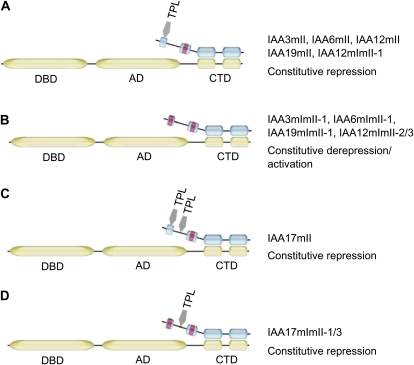Figure 7.
Model for auxin response gene expression with different IAA domain I mutations. In this model, repression or activation of auxin response genes depends on whether a repression domain in an IAA protein functions or not (e.g. whether the repression domain interacts with a corepressor, TPL). A, IAA proteins such as IAA3, IAA6, IAA12, and IAA19 contain a single Leu-rich repression domain (domain I) that interacts with TPL to bring about the repression of auxin response genes. Mutations that destroy the degron in domain II (represented by the red box in domain II) permit auxin-independent, stable association of these IAA proteins with ARF activators, resulting in constitutive repression of auxin response genes (e.g. IAA3mII, IAA6mII, IAA12mII, and IAA19mII). Wild-type repressors like IAA3, IAA6, and IAA12 would also interact with ARF activators to repress auxin response genes, but this repression would be relieved by the destruction of IAA3, IAA6, and IAA12 when auxin levels are elevated. B, An Ala substitution (represented by the red box in domain I) for the first Leu in the LxLxL repression domain of IAA proteins such as IAA3, IAA6, and IAA19 impairs or prevents these IAA proteins from interacting with TPL, resulting in the loss of repression. Mutations in the degron of domain II would again promote auxin-independent, stable association of these IAA proteins with ARF activators (e.g. IAA3mImII-1, IAA6mImII-1, and IAA19mImII-1). This stable association would prevent natural IAA repressors from interacting with ARF activators, which in turn would allow the ARF activation domain to function and result in constitutive activation of auxin response genes. IAA12 has an LxLxLxLxL motif in place of the more common LxLxL motif. Mutation of a single Leu residue in the LxLxLxLxL motif of domain I in IAA12 does not prevent repression, presumably because it can still interact with TPL. Thus, a stable form of IAA12 with a single Ala substitution in domain I (i.e. IAA12mImII-1) results in constitutive repression of auxin response genes (as in A). Additional Ala substitutions in the LxLxLxLxL motif of IAA12 impair the repression domain and result in constitutive activation of auxin response genes when IAA12 is stabilized by a mutation in domain II (e.g. IAA12mImII-2 and IAA12mImII-3). C, IAA proteins such as IAA17 contain a second repression motif located between domains I and II. This motif together with LxLxL in domain I results in repression of auxin response genes, and stabilization of IAA17 results in constitutive repression (e.g. IAA17mII). Wild-type repressors like IAA17 would also interact with ARF activators to repress auxin response genes, but this repression would be relieved by the destruction of IAA17 when auxin levels are elevated. D, An Ala substitution for the first Leu or additional Leu residues in the LxLxL motif of domain I in IAA17 prevents domain I interactions with TPL; however, a second LxLxL motif located between domains I and II in these IAA proteins still functions, and repression is maintained. Stabilization of the IAA17 protein with a nonfunctional repression domain in domain I results in constitutive repression of auxin response genes due to the second repression domain in these proteins (e.g. IAA17mImII-1 and IAA17mImII-3). DBD, DNA-binding domain; AD, activation domain; CTD, carboxyl terminal domain.

